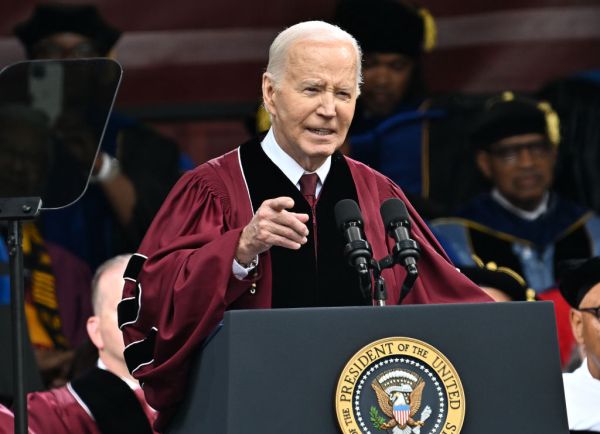Happy Thursday! A 3.5-foot statue of the Twitter logo sold for $100,000 at auction this week as the social media company seeks to both boost revenue and unload supplies from its San Francisco headquarters after thousands of employees were laid off.
To the person who finished second in the bidding: You clearly have some disposable income, can we interest you in 1,000 annual gift subscriptions to The Dispatch?
Quick Hits: Today’s Top Stories
- Fourteen people were killed and 25 more wounded when a helicopter crashed near a nursery school in a city near Kyiv on Wednesday. Ukraine’s interior minister Denys Monastyrsky and state secretary Yuriy Lubkovich were among those killed, but the cause of the crash—and whether Russia was behind it—remains unclear.
- New Zealand Prime Minister Jacinda Ardern announced this morning she will step down from her post by early next month, opting not to run for re-election in October after leading the Oceanic nation since 2017. “Leading a country is the most privileged job anyone could ever have, but also the most challenging,” the center-left 42 year old told reporters. “You cannot and should not do the job unless you have a full tank, plus a bit in reserve for those unplanned and unexpected challenges.” Another Labour Party leader will be sworn in upon Ardern’s resignation, but the party’s standing has plummeted in the polls and Ardern’s replacement could face an uphill climb in this year’s election.
- The Commerce Department reported Wednesday that U.S. retail sales fell 1.1 percent month-over-month in December, the largest such decline of 2022, just ahead of November’s 1 percent drop. The data is yet another indicator pointing toward a slowing economy as the Federal Reserve hikes interest rates, and the Dow Jones Industrial Average fell more than 600 points yesterday as investors price in the likelihood of a recession.
- The Labor Department reported Wednesday that the producer price index (PPI)—a measure of what suppliers and wholesalers are charging customers—rose 6.2 percent year-over-year in December, down from November’s 7.3 percent annual rate and the measure’s lowest reading since March 2021. Core PPI—which excludes food and energy prices—slowed to a 4.6 percent annual rate in December.
- The United Kingdom’s Office for National Statistics reported Wednesday that annual inflation in the U.K. fell for the second consecutive month, from 10.7 percent in November to 10.5 percent in December. Core inflation remained unchanged at 6.3 percent, leading investors to believe the Bank of England will continue hiking interest rates in the coming months.
Age Before Wealth

China’s one-child policy once promised “one mouth, six pockets,” as four grandparents and two parents could shower all their affection—and resources—on one lucky kid. But as those parents and grandparents retired without enough young people to replace them, demographers warned the pyramid would flip, leaving those only children scrambling to fill six pockets solo.
The dynamic has already been playing out for a few years, but it hit a milestone this Tuesday when China’s National Bureau of Statistics reported the country’s population declined by 850,000 people in 2022—the first population drop since the 1960s, when famines caused by Mao Zedong’s “Great Leap Forward” killed tens of millions of people. China is still officially the most populous country in the world with 1.4 billion people—India is catching up quickly—but last year’s decline is likely the first of many.
Chinese Communist Party officials began softening China’s one-child policy in 2016 to allow nuclear families of four and five—and the code was never quite universal anyways—but the country’s demographic trends have continued their downward trajectory. China’s median age was about 20 in 1978 and by 2021 had climbed to about 38, reflecting both improved health and longevity for elders and the slowing birth rate. Parents aborted girls at higher rates during the one-child policy, in part due to a traditional preference for boys, so as of 2018 it was estimated China had 34 million more men than women—hardly an ideal balance for increased procreation. The country’s fertility rate is 1.18, well below the 2.1 needed for a stable population, and the United Nations projects China’s population will drop from its current 1.4 billion to below 800 million by 2100. (The United States’ fertility rate is also well below 2.1, but—thanks largely to healthy immigration levels—the Congressional Budget Office projects the American population will grow at an average annual rate of 0.3 percent over the coming three decades, reaching 369 million in 2052.)
The coercive nature of the one-child policy—and the CCP’s more recent forced sterilization of Uyghurs and other ethnic and religious minorities—aren’t the only culprit. Fertility rates tend to drop as countries develop for a variety of reasons: Parents increasingly expect their offspring to survive childhood, for example, and women with more access to education and employment often choosing to have fewer children—or none at all.
Cultural changes and urbanization—with accompanying high housing costs—also play a role. “Raising children is expensive and difficult,” said David Dollar, a senior fellow in the John L. Thornton China Center at the Brookings Institution. “It’s a big burden on women in China.” Attempts at pro-natalist policy—extra parental leave in Shanghai, subsidies for having a third child in a few cities—can encourage couples to have kids somewhat sooner, but research doesn’t guarantee such policies can reverse the decline. “I don’t have much hope that [China’s government] can induce people to have babies who don’t want to have babies,” Dollar told The Dispatch.
And China is—as the analysts like to put it—getting old before getting rich. Japan and South Korea also have aging populations, but their respective gross domestic products per capita are north of $40,000, while China’s is closer to $20,000. One 2013 study estimated that about a quarter of China’s elderly live below the poverty line. “Life is still very hard in China for a lot of people,” Dollar said. “So the notion that this is where they plateau—that’s going to be a tough one to accept for most people in China.”
An aging population tends to come with stagnating growth—estimated at about a 1 to 1 percentage point ratio, according to an analysis by Ruchir Sharma, former head of emerging markets at Morgan Stanley. Companies will face higher costs as they compete for labor, and China’s government will be spending more on elder care while drawing from a shrinking tax base. “That means less money for investing in current needs for the vast majority of the workforce, for infrastructure, for upgrading,” said Scott Kennedy, an expert in China’s economy at the Center for Strategic and International Studies. “This is the mechanism of how you get slower growth over a long period of time as a population ages.”
The economic damage of these pressures likely won’t be felt immediately, unlike the country’s widespread COVID-19 shutdowns of the past few years. After two-digit growth in previous years and 8.1 percent recorded growth in 2021, China reported a comparatively dismal 3 percent GDP growth in 2022, and some officials anticipate a target of 5 percent growth for 2023, which is optimistic but not necessarily impossible. But economists expect this story to grind on in the background year after year, compounding existing economic problems. China already has an unusually large amount of debt for a nation at its developmental stage—public and private debt topped 300 percent of its GDP in 2019—which will be painful to service over the next few decades. And its overstretched real estate market won’t be helped by sinking demand from a declining population.
But Beijing does have some levers to pull. Chinese officials could further raise retirement ages, for example. The government has promoted automation, which may help ease worker shortages, and could switch from discouraging rural-urban migration to encouraging it—urban workers tend to be more productive, per capita, in part thanks to economies of scale. Chinese officials have painted cheery pictures of the country’s economic recovery for international businesses, perhaps hoping to lure investment scared off by restrictive COVID-19 policies and government interference in tech companies. Immigration, though useful for other countries, is an unlikely solution: A stagnating economy doesn’t tend to attract immigrants, and the country’s still-massive population means it would take a whole lot of migration to plug its labor leaks.
No matter how effective their reforms, Chinese officials probably can’t halt the economic impacts of a demographic decline—and that has global implications as China’s powerhouse status fades, even if only slightly. “China’s had a voracious appetite for energy and minerals, things like iron and copper [for] this giant construction boom,” Dollar said. “It’s not going to provide the same demand for those kinds of products.” China’s energy demand could also sink, along with its demand for high-end electronics and cars from American companies.
Other countries may find silver linings to these changes. If Chinese labor gets scarcer and therefore more expensive, for instance, Southeast Asian, Indian, and even American manufacturing might pick up some of the slack. “It’s not going to affect China’s economy one way or the other in any individual year, but over the long term, labor intensive sectors in China are going to face mounting costs,” Kennedy told The Dispatch. “China’s position as the world’s factory floor is going to be shaken.”
Worth Your Time
- For more on demographic trends, Lyman Stone has some encouraging data over at the Institute for Family Studies: The percentage of children living in intact, two-parent households appears to be rising again after decades of steep decline. “What’s driving this comeback of the intact nuclear family? The answer is a mixture of good and bad news,” he writes. “Divorce and widowhood rates have fallen appreciably, suggesting that the marriages formed in recent years may be more durable than marriages formed in the 1950s to 1990s, on average. That’s good news, as divorce can create extraordinarily damaging instability for children. But the decline in divorce isn’t the whole story. Marriage rates have fallen too; indeed, that may be a cause for the decline in divorce. In particular, poorer Americans get married far less than in the past, meaning that marriage today is more concentrated among wealthier Americans, who have had lower divorce rates for many decades.” If marriage rates are falling, how are more kids living with married parents? “Fertility rates are falling faster than marriage rates, especially among unmarried women,” Stone writes. “As a result, the children who are born are more likely to live with two married parents.”
- Did November’s surprising midterm results give Democrats—and President Joe Biden—a false sense of security heading into 2024? “They apparently think the legislation they are focusing on, plus the association of the GOP with unpopular Trumpian antics, will function as a get-out-of-jail-free card with the electorate, and that their cultural problem can be safely ignored,” progressive political scientist Ruy Teixeira writes for UnHerd. “The idea that Democrats can just turn up the volume on economic issues and ignore their unpopular stances on sociocultural issues is absurd. Culture matters and the issues to which they are connected matter. They are a hugely important part of how voters assess who is on their side and who is not; whose philosophy they can identify with and whose they can’t. Instead, for working-class voters to seriously consider their economic pitch, Democrats need to convince them that they are not looked down on, that their concerns are taken seriously and that their views on culturally freighted issues will not be summarily dismissed as unenlightened. With today’s party, unfortunately, this will be difficult.”
Presented Without Comment
Also Presented Without Comment
Also Also Presented Without Comment
Toeing the Company Line
- Fans of Really Simple Syndication, rejoice! The Dispatch now has more than a dozen RSS feeds available, allowing you to easily keep up with your favorite newsletters, writers, and topics. Simply copy and paste whichever feed you’re interested in into your RSS reader of choice, and you’ll never miss a post. If you run into any trouble, shoot us a note at members@thedispatch.com.
- Brian Riedl, also known as the “balanced budget good government guy,” is back on The Remnant to answer a pertinent question: Should we believe Republicans’ sudden awakening on fiscal responsibility? Plus: What’s to be done about the national debt? How should conservatives approach the IRS? And is it possible to reform the tax system?
- On today’s episode of Advisory Opinions, David and Sarah tick through a number of last-minute cert grants at the Supreme Court. A consolidated immigration case. A legal battle between a 93-year-old woman and the state of Minnesota over a foreclosed condo. A search for the line between free speech and death threats. This podcast has it all.
- On the site today, Kevin explains why balancing the federal budget is easier said than done, Audrey walks through how classified documents should be handled, and Chayenne Polimedio digs into what the insurrection in Brazil means for President Luis Inácio Lula da Silva’s term in office.
Let Us Know
Alternative history time: How do you think the American people would have reacted if the federal government tried to implement a one-child policy in the 1980s?







